Categories > Guides and Tips

Our Guide to the Temple of the Emerald Buddha in Bangkok
- Best Time to Go
- Things to Know
- How to Get to Wat Phra Kaew
- Fun Facts about Wat Phra Kaew
- Wat Phra Kaew holds a significant place in Thai history
- The Emerald Buddha was carved from a single piece of jade
- The Emerald Buddha statue is relatively small
- The Emerald Buddha’s robe changes depending on the season
- The statue can only accessed by the Thai King
- The Emerald Buddha is enshrined in the Ubosot
- Wat Phra Kaew is guarded by the temple guards
- The murals in the temple depict scenes from the Ramayana
- The temple is filled with Royal Decorations during special events and celebrations
- What to Do at Wat Phra Kaew
- Admire the Emerald Buddha
- Explore the temple grounds
- Pay respect and observe rituals
- Marvel at the architecture
- What to Expect at Wat Phra Kaew, Bangkok Weather
The Temple of the Emerald Buddha (Wat Phra Kaew) landmark in Bangkok is not just about the statue–it’s an entire world waiting to be explored. From the intricate details of the buildings to the vibrant colours that adorn every surface, there’s beauty at every turn.
To uncover the magic that awaits within these sacred walls, we’ve put together a guide that will take you on a journey to fully experience the Temple of the Emerald Buddha!
Best Time to Go
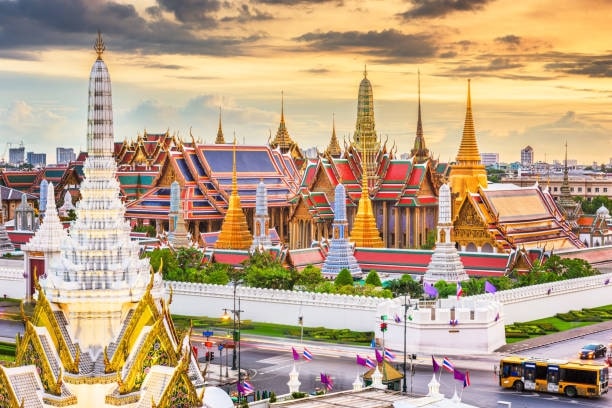
The best time to visit the Temple of the Emerald Buddha is during early morning or late afternoon, as the temple complex can get crowded during peak hours. Plus, Bangkok’s hot and humid weather is more tolerable during these times.
If you’re visiting during the morning, you may have the chance to witness or participate in the daily religious ceremonies or offerings. This can provide a unique and authentic cultural experience.
Things to Know
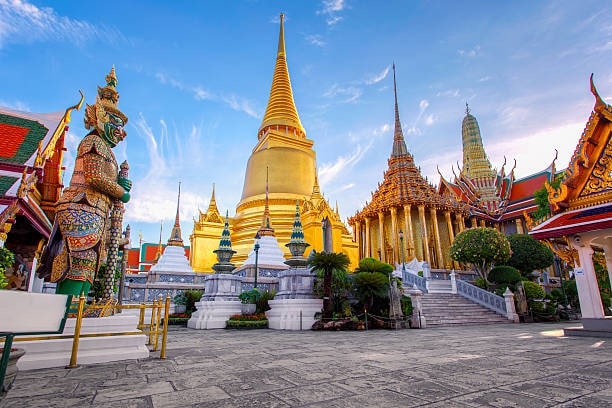
Time Zone: Indochina Time (GMT+7)
Currency: Thai Baht (Check the current exchange rate)
Language: Thai
Address: QF2V+M34, Na Phra Lan Rd, Phra Borom Maha Ratchawang, Phra Nakhon, Bangkok 10200, Thailand
Contact details: +6628912185
Website: https://www.facebook.com/watarunofficial/
Operating hours: Daily 8:30 AM to 3:30 PM
Entrance fee: 500 THB
Dress Code: As a religious site, visitors are expected to dress modestly. Both men and women should cover their shoulders and wear clothing that covers their knees.
Footwear: Shoes must be removed before entering the temple buildings, so it’s advisable to wear comfortable slip-on shoes or sandals.
Photography: Photography is generally allowed in the outdoor areas of the temple complex, but it is prohibited inside the temple buildings where the Emerald Buddha is located. Be respectful of any signage or instructions regarding photography.
How to Get to Wat Phra Kaew
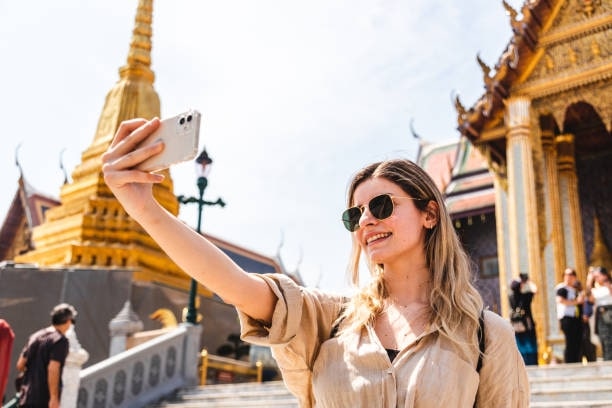
By Skytrain (BTS): Take the BTS Skytrain to Saphan Taksin Station (S6) on the Silom Line. From there, you can either take a taxi or a Chao Phraya Express Boat to Tha Chang Pier (N9).
By Bus: Several buses, such as Bus No. 3, 6, 9, 32, 43, and 44, have stops near the Grand Palace area. Check the local bus routes and schedules to find the one that suits your location.
By Boat: Take a Chao Phraya Express Boat and disembark at Tha Chang Pier (N9). The pier is located just a short walk away from the Grand Palace complex.
By Taxi: Taxis are a convenient option to reach Wat Phra Kaew. Ensure that the taxi driver uses the metre or agrees on a fare before starting the journey. It’s helpful to have the Thai name or address of the temple written down to show the driver.
By Tuk-Tuk: Tuk-tuks are a popular mode of transportation in Bangkok. Negotiate the fare with the driver before starting the ride, and keep in mind that they may not have metres.
By Walking: If you are staying in the vicinity, you can walk to the Grand Palace area. Use a map or navigation app to find the most direct route.
Fun Facts about Wat Phra Kaew
Wat Phra Kaew holds a significant place in Thai history
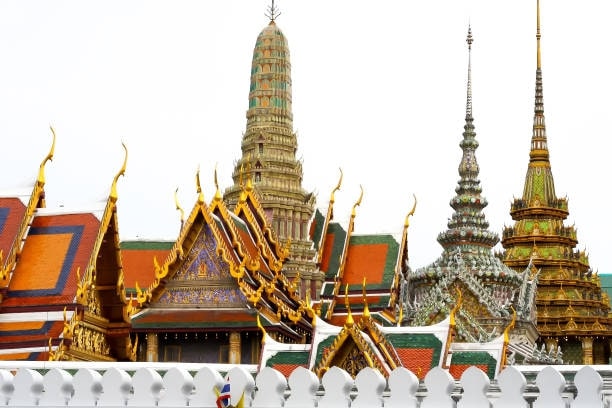
It was constructed back in 1782 during the reign of King Rama I, the visionary founder of the esteemed Chakri Dynasty. This grand temple stands as a testament to the rich cultural heritage and deep spiritual traditions of Thailand.
Over the centuries, Wat Phra Kaew has been lovingly maintained and adorned with intricate details that showcase the exquisite craftsmanship of Thai artisans.
It serves as a sacred space where devotees and visitors alike can pay homage to the revered Emerald Buddha, a breathtaking statue carved from a single piece of jade.
The Emerald Buddha was carved from a single piece of jade
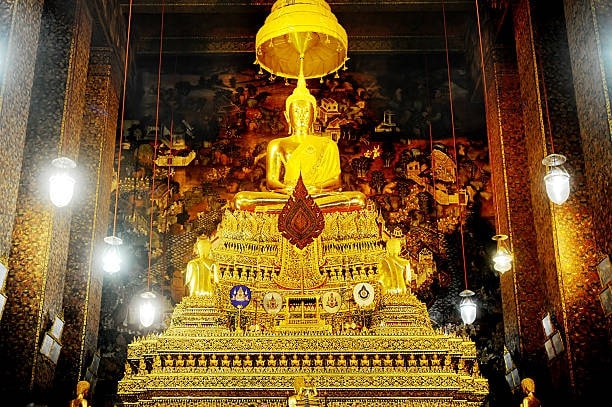
The Temple of the Emerald Buddha holds within its hallowed walls a truly remarkable artefact: the highly revered Emerald Buddha statue.
This awe-inspiring statue, with its rich history and profound spiritual significance, is believed to have originated in India during the 15th century.
Legend has it that the Emerald Buddha was carved from a single piece of jade, giving it an ethereal glow that captures the imagination of all who lay eyes upon it.
Despite its name, the statue is actually made of green jasper, known for its vibrant and lustrous appearance.
The Emerald Buddha, believed to bring prosperity and blessings, is the focal point of the temple and holds immense spiritual significance for the Thai people.
The Emerald Buddha statue is relatively small
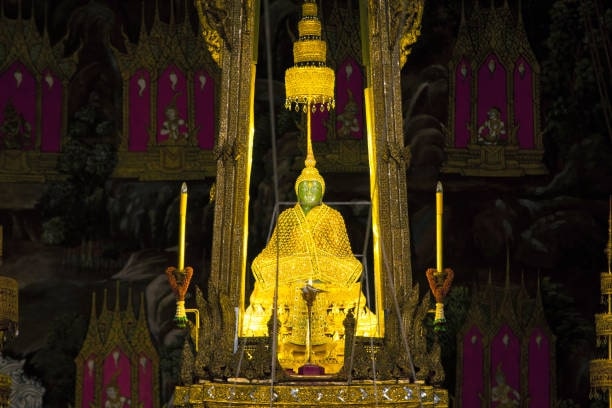
The Emerald Buddha statue is relatively small, standing at approximately 66 centimetres (26 inches) tall and carved from a single block of jade.
The size of the Emerald Buddha statue belies its profound impact on the Thai people and visitors alike. It serves as a powerful symbol of spiritual enlightenment, compassion, and inner peace.
The small scale of the Emerald Buddha statue also contributes to its intimate and personal nature.
The Emerald Buddha’s robe changes depending on the season
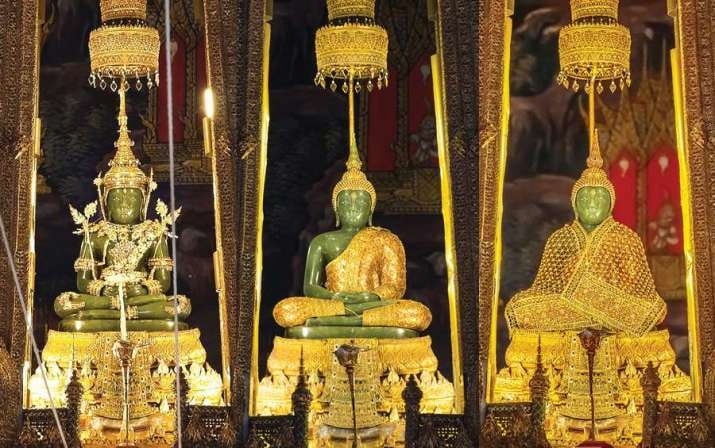
A fascinating tradition that takes place within the Temple of the Emerald Buddha is the Changing of the Robes ceremony for the revered statue.
The Emerald Buddha is adorned with three different sets of exquisite gold robes, which are changed with great reverence and precision by either the Thai King or a high-ranking royal representative.
This sacred ritual is performed during significant ceremonies to coincide with the changing seasons.
Each set of robes holds symbolic meaning and reflects the essence of the particular season it represents.
The first set, known as the Summer Robes, features light and airy designs, adorned with intricate patterns and delicate details, signifying vitality, growth, and abundance.
As the season transitions to the rainy period, the second set of robes, known as the Rainy Season Robes, is carefully placed upon the Emerald Buddha. These robes are characterised by their elegant simplicity and watery motifs, symbolising tranquillity and purification.
Finally, the third set of robes, known as the Winter Robes, graces the Emerald Buddha during the cool and dry season. These robes exude opulence, featuring intricate patterns, ornate embellishments, and warm colours.
They represent prosperity, abundance, and the joyous festivities that come with the winter season.
The statue can only accessed by the Thai King

One of the unique aspects of the Temple of the Emerald Buddha is its restricted access and the exclusive privilege bestowed upon only a select few individuals to interact directly with the revered Emerald Buddha statue.
Within the temple’s sacred confines, a strict protocol is observed, and only the Thai King and the Crown Prince are granted permission to touch the statue and perform the solemn ritual of changing its robes.
This exclusive privilege is a testament to the profound reverence and deep spiritual significance attached to the Emerald Buddha.
The Emerald Buddha is enshrined in the Ubosot
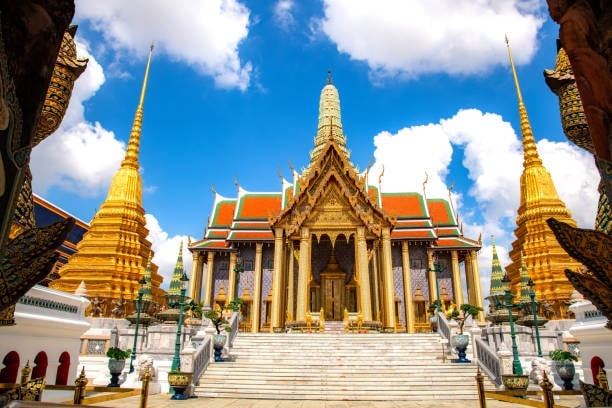
At the heart of the Temple of the Emerald Buddha lies the Ubosot, the holiest and most sacred building within the temple complex.
It is here that the Emerald Buddha, the revered centerpiece of the temple, is enshrined. The Ubosot serves as a place of worship, meditation, and spiritual contemplation.
Wat Phra Kaew is guarded by the temple guards
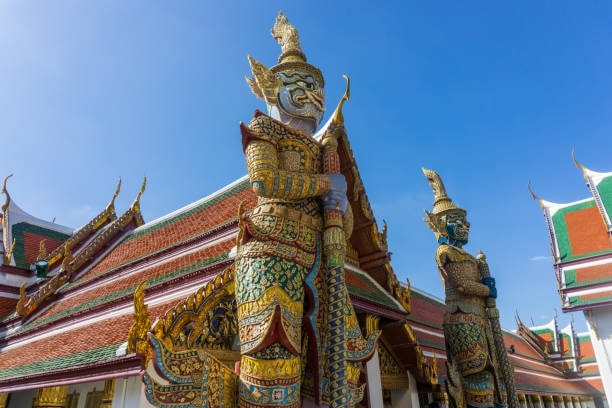
As you explore the Temple of the Emerald Buddha, you will encounter the famous Emerald Buddha Temple Guards, also known as yakshas, who stand vigilantly, lending an air of mystique to the temple complex.
These Temple Guards are mythical creatures deeply rooted in Thai folklore and legends. With their fierce expressions and muscular physiques, they exude a sense of power and protection.
These yakshas serve as symbolic protectors of the temple, warding off evil spirits and ensuring the sanctity of the sacred space.
The murals in the temple depict scenes from the Ramayana
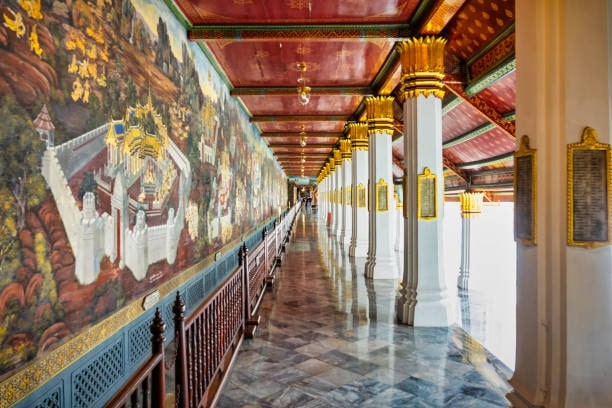
Stepping inside the Temple of the Emerald Buddha, you will be greeted by a mesmerising sight: the walls adorned with intricate murals that tell captivating stories.
These murals depict scenes from the Ramayana, a Hindu epic that holds great significance in Thai culture and mythology.
Beyond the Ramayana, the murals also depict other religious stories and folk tales, showcasing the diverse cultural influences that have shaped Thailand’s artistic heritage.
The temple is filled with Royal Decorations during special events and celebrations
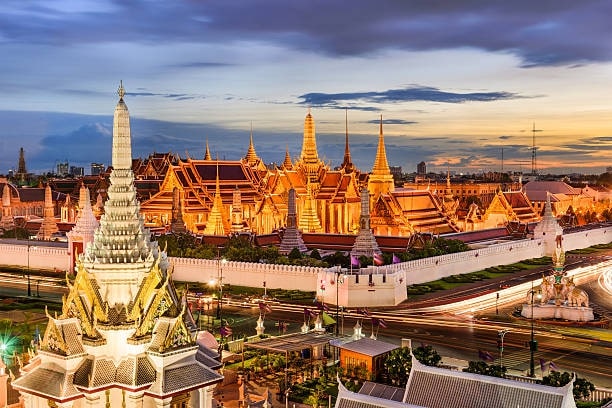
During special occasions, festivals, or grand celebrations, the Temple of the Emerald Buddha undergoes a remarkable transformation.
The temple and the Emerald Buddha statue are adorned with regal and extravagant decorations, showcasing the splendour and opulence befitting its status as a revered royal temple.
Gold ornaments and precious gemstones are carefully placed, adorning the architecture and highlighting the intricate details of the temple’s design.
These royal decorations serve as a visual testament to the deep respect and devotion of the Thai people towards their monarchy and spiritual heritage.
They symbolise the unity of art, culture, and spirituality, reflecting the profound connection between the temporal and the divine.
What to Do at Wat Phra Kaew
Admire the Emerald Buddha
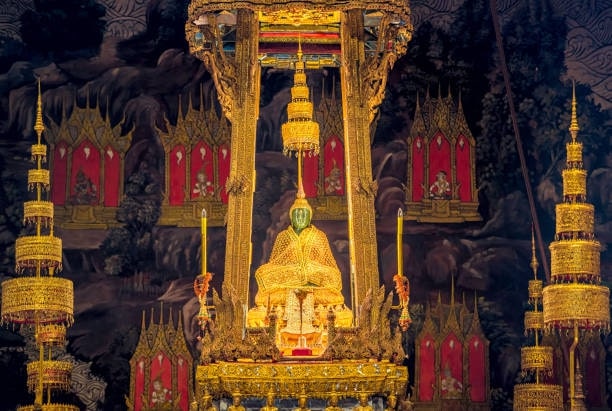
For many visitors, the opportunity to witness the Emerald Buddha in person is a transformative experience.
You’ll find that it sparks a connection with the rich history, cultural heritage, and deep spirituality of Thailand. It’s undoubtedly one of the main reasons why people flock to this sacred site.
Also, the statue is mind-blowing and the level of detail and craftsmanship is just incredible! It’s made from a single piece of jade and stands about 66 centimetres tall. You can’t help but be in awe of its beauty and the spiritual vibe it gives off.
Explore the temple grounds
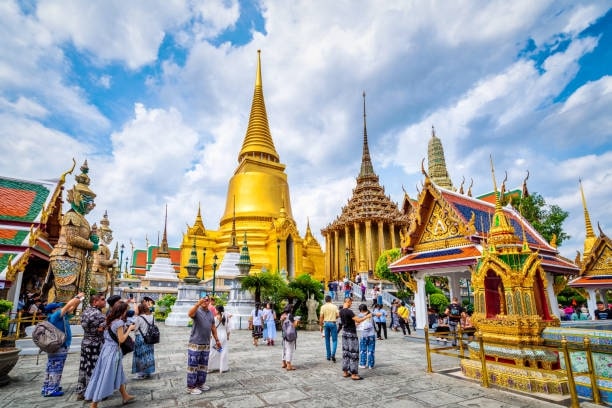
Once you’ve soaked in the awesomeness of the Emerald Buddha, it’s time to explore the temple grounds. The architecture here is off the charts!
The colours, the carvings, everything is so vibrant and intricate. Take your time wandering around, checking out the different buildings.
You’ve got the Ubosot, where important ceremonies happen, and the chedis (stupas) that are simply stunning. And don’t forget to enjoy the gardens too—they’re so peaceful and calming.
Pay respect and observe rituals
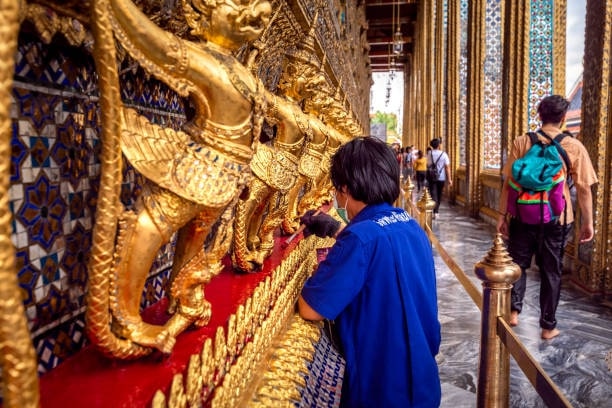
While you’re there, don’t be shy to observe the rituals and pay your respects. You’ll see people making offerings and saying their prayers. It’s quite a spiritual experience to witness.
If you feel like joining in, go ahead! Light some incense or make your own little offering.
Marvel at the architecture
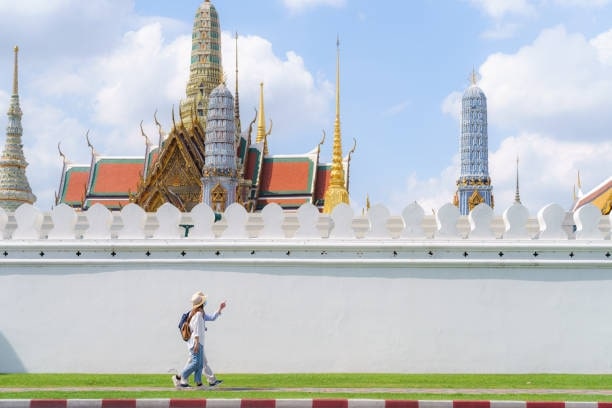
The mix of Thai, Khmer, and other Southeast Asian styles is mind-boggling. Everywhere you look, there are intricate carvings, stunning murals, and a sense of grandeur. It’s like stepping into another world.
What to Expect at Wat Phra Kaew, Bangkok Weather

Bangkok has a tropical savanna climate, characterised by hot and humid weather throughout the year. Here are some general weather patterns to keep in mind:
Hot and Humid: Bangkok experiences high temperatures and high humidity levels, particularly from March to May. During these months, temperatures can soar above 30°C (86°F).
Be prepared for hot and sweaty conditions and ensure you stay hydrated.
Rainy Season: The rainy season in Bangkok typically occurs from May to October. Expect regular rainfall, sometimes in the form of heavy downpours or thunderstorms.
It’s a good idea to carry an umbrella or a raincoat during this time and be prepared for occasional disruptions due to rain.
Cooler Months: The cooler and more pleasant months in Bangkok are from November to February. Temperatures are relatively cooler, ranging from 20°C to 30°C (68°F to 86°F), and the humidity is slightly lower.
This period is considered the peak tourist season, so expect larger crowds at popular attractions like Wat Phra Kaew.





